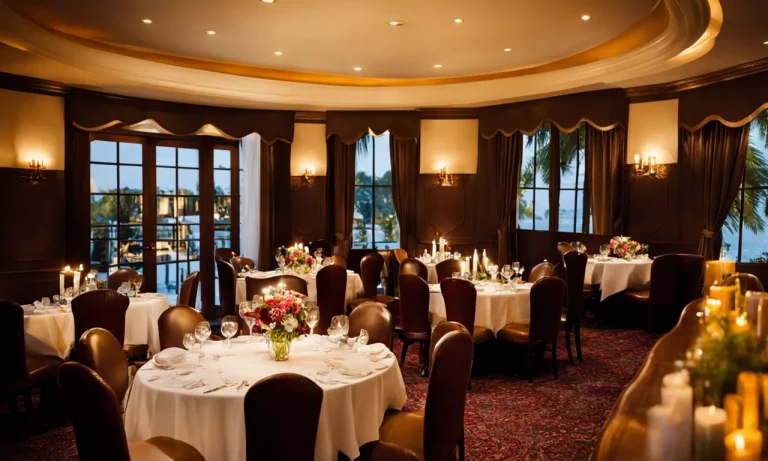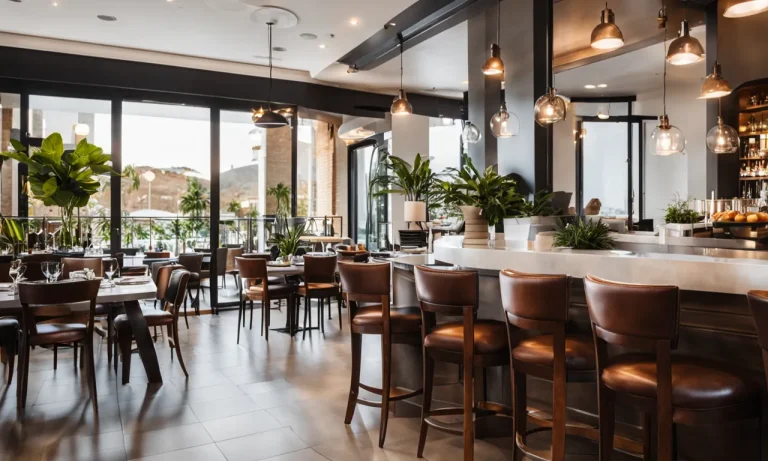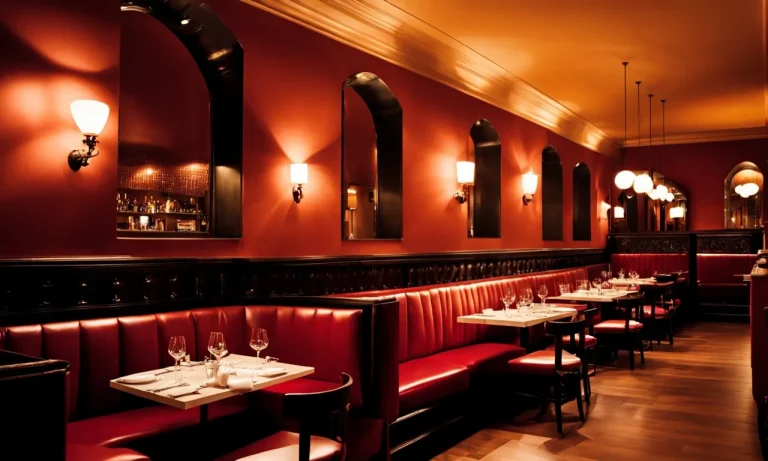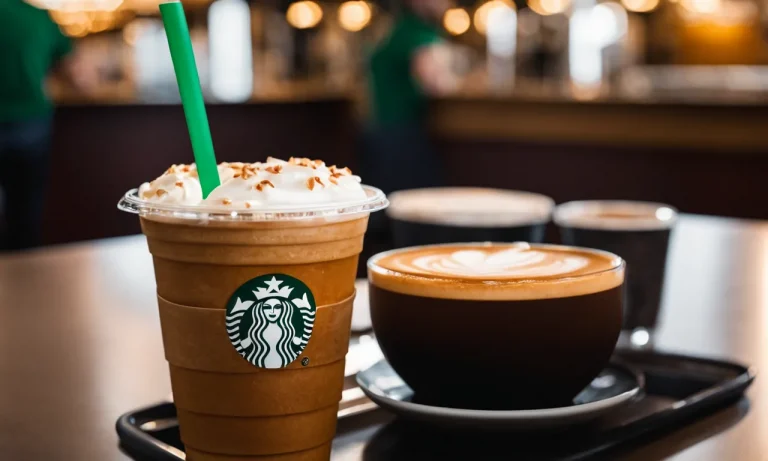Finding a top-rated restaurant can be a daunting task. With so many review sites and rating metrics to consider, how do you know which restaurant truly reigns supreme? This comprehensive guide will walk you through the highest possible restaurant ratings and what they mean.
If you’re short on time, here’s a quick answer: Michelin 3-star restaurants represent the absolute pinnacle of culinary excellence, with flawless cuisine and service.
In this article, we’ll explore the different rating systems used by Michelin, Zagat, James Beard, AAA Diamonds, Forbes Travel Guide, and more. You’ll learn about the rigorous criteria and inspection processes behind a perfect restaurant score.
We’ll also showcase examples of some of the world’s best 3-star Michelin restaurants and discuss what makes them worthy of the ultimate culinary honor.
Understanding Michelin 3-Star Rating
Origins and Meaning of Michelin Stars
The Michelin star rating system is one of the most esteemed and influential culinary rating systems in the world. It originated from the Michelin Guide, a publication created by the Michelin tire company in 1900 to encourage more people to travel and, in turn, wear out their tires.
Over time, the guide began to include restaurant recommendations, and in 1926, the Michelin star rating system was introduced.
The Michelin star rating system uses a scale of one to three stars to rate restaurants based on their overall quality, with three stars being the highest achievement. The meaning behind each star has evolved over the years, but generally, a one-star restaurant is considered very good, a two-star restaurant is deemed excellent, and a three-star restaurant is considered exceptional and worth a special journey.
Inspection Criteria for Earning Stars
Earning a Michelin star is no easy feat. The inspection process is rigorous and anonymous, with trained inspectors visiting each restaurant multiple times. Inspectors assess several key factors, including the quality of the ingredients, the mastery of flavors and cooking techniques, the consistency of the dishes, and the overall dining experience.
Restaurants that aspire to earn a Michelin star must consistently deliver exceptional cuisine that exceeds expectations. Attention to detail, creativity, and innovation are also highly valued by the inspectors.
It’s important to note that Michelin stars are awarded to the restaurant as a whole, rather than individual chefs.
Examples of Top 3-Star Michelin Restaurants
Receiving a three-star Michelin rating is an extraordinary achievement, reserved for only the most exceptional restaurants in the world. Some renowned examples of three-star Michelin restaurants include:
- Osteria Francescana in Modena, Italy: Chef Massimo Bottura’s innovative and artistic approach to Italian cuisine has earned his restaurant three Michelin stars.
- Eleven Madison Park in New York City, USA: This restaurant, led by chef Daniel Humm, offers a refined and creative dining experience that has garnered it three Michelin stars.
- El Celler de Can Roca in Girona, Spain: The Roca brothers’ culinary mastery and dedication to pushing the boundaries of traditional Catalan cuisine have earned their restaurant three Michelin stars.
These restaurants represent the pinnacle of culinary excellence and attract food enthusiasts from around the world. Achieving a three-star Michelin rating is a testament to the exceptional skill, creativity, and dedication of the entire restaurant team.
For more information on the Michelin star rating system and the restaurants that have earned this prestigious recognition, visit the Michelin Guide website.
Other Notable Restaurant Rating Systems
Zagat
Zagat is a well-known restaurant rating system that has been around since 1979. It started as a small survey conducted by Tim and Nina Zagat, who asked their friends and colleagues to rate their favorite restaurants in New York City.
Today, Zagat covers various cities across the United States and provides ratings based on food, service, decor, and cost. Their ratings are compiled into a guidebook that helps diners make informed choices about where to eat.
James Beard Awards
The James Beard Awards are often referred to as the “Oscars of the food world.” Named after the legendary American chef James Beard, these awards recognize culinary excellence in various categories, including Best Chef, Outstanding Restaurant, and Outstanding Pastry Chef.
The winners are selected by a panel of industry professionals, including chefs, restaurateurs, and food journalists. The James Beard Awards not only highlight outstanding restaurants but also contribute to the growth and development of the culinary industry.
Forbes Travel Guide 5-Star
The Forbes Travel Guide 5-Star rating is highly regarded in the hospitality industry. It assesses hotels, restaurants, and spas based on strict criteria, including service, amenities, cleanliness, and overall guest experience.
Restaurants that receive a 5-star rating from Forbes are considered to be among the best in the world. This prestigious recognition can significantly elevate a restaurant’s reputation and attract discerning diners from around the globe.
AAA Diamond Rating
The AAA Diamond Rating system is widely recognized in North America and has been evaluating hotels and restaurants for over 80 years. Restaurants are rated on a scale of one to five diamonds, with five diamonds representing the highest level of excellence.
AAA’s team of professional inspectors conducts anonymous visits to assess the quality of food, service, and ambiance. The AAA Diamond Rating provides a reliable benchmark for diners looking for exceptional dining experiences.
La Liste 100
La Liste is an international restaurant rating system that compiles rankings from various food guides and critics worldwide. Launched in 2015, it aims to provide a comprehensive list of the best restaurants globally.
The La Liste 100 is an annual list that ranks restaurants based on a scoring system that takes into account reviews from a wide range of sources. It serves as a valuable resource for food enthusiasts who want to explore the top culinary destinations around the world.
These notable restaurant rating systems offer valuable insights for diners seeking exceptional culinary experiences. Whether it’s Zagat’s comprehensive guide, the prestigious James Beard Awards, the esteemed Forbes Travel Guide 5-Star rating, the trusted AAA Diamond Rating, or the international rankings of La Liste 100, these systems help diners make informed decisions and celebrate the best in the culinary world.
Achieving a Perfect Restaurant Score
Common Traits of Top-Tier Restaurants
Top-tier restaurants that achieve a perfect score share several common traits. Firstly, they prioritize exceptional customer service, ensuring that each guest feels valued and well taken care of. This includes prompt and attentive waitstaff, friendly and knowledgeable hosts, and a welcoming atmosphere.
Additionally, these restaurants maintain high standards of cleanliness and hygiene, ensuring that their dining areas, kitchens, and restrooms are spotless at all times.
Furthermore, top-tier restaurants focus on sourcing the highest quality ingredients for their dishes. They work closely with local farmers and suppliers to obtain fresh and seasonal produce, ensuring that each plate is bursting with flavor.
These establishments often have talented chefs who are skilled in creating innovative and delicious culinary creations that leave a lasting impression on diners.
Finally, top-tier restaurants pay attention to every detail, from the presentation of their dishes to the ambiance of their dining spaces. They strive to create an unforgettable dining experience by carefully curating their menus, selecting the perfect wine pairings, and creating a visually appealing environment that enhances the overall enjoyment of the meal.
Challenges in Maintaining Excellence
Maintaining excellence and achieving a perfect restaurant score is no easy feat. It requires constant dedication, hard work, and attention to detail. One of the main challenges faced by top-tier restaurants is consistency.
They need to ensure that every dish is prepared with the same level of skill and precision, regardless of the day or time.
Another challenge is the ever-changing expectations of diners. As the culinary landscape evolves and new trends emerge, restaurants must adapt to meet the demands of their customers. This means staying updated with the latest cooking techniques, incorporating new flavors and ingredients, and continuously innovating their menus to stay ahead of the competition.
Additionally, maintaining a high level of customer satisfaction can be challenging. With the rise of online review platforms, every aspect of a restaurant’s service is scrutinized and can have a significant impact on its reputation.
Restaurants must consistently deliver exceptional experiences to ensure positive reviews and word-of-mouth recommendations.
How Ratings Influence Diners’ Expectations
Ratings play a crucial role in shaping diners’ expectations. When a restaurant achieves a high score or receives positive reviews, it creates a sense of trust and confidence among potential customers. Diners are more likely to choose a restaurant with a stellar rating, expecting a memorable dining experience.
On the other hand, poor ratings or negative reviews can deter diners from choosing a particular restaurant. In today’s digital age, where information is readily available, potential customers often rely on online ratings to make dining decisions.
A restaurant’s rating can impact its overall success and its ability to attract new customers.
However, it is important to note that ratings should not be the sole determining factor when choosing a restaurant. Personal preferences, cuisine preferences, and individual tastes should also be taken into consideration.
It is always a good idea to explore different sources of information, such as reputable food blogs and trusted recommendations from friends or family, to get a well-rounded understanding of a restaurant’s quality.
The Future of Restaurant Ratings
In the ever-evolving world of dining, restaurant ratings play a crucial role in helping customers make informed choices about where to eat. But what does the future hold for restaurant ratings? Let’s take a closer look at some exciting developments shaping the future of this industry.
New Rating Criteria and Methods
Gone are the days when restaurant ratings were solely based on traditional factors such as food quality and service. Today, there is a growing emphasis on incorporating a broader range of criteria to provide a more comprehensive assessment.
Factors such as sustainability practices, ethical sourcing, and community impact are now being considered alongside the traditional aspects.
This shift is a reflection of evolving consumer preferences. Diners are increasingly conscious of the environmental and social impact of their choices. As a result, restaurants that prioritize sustainability and ethical practices are gaining favor among customers, leading to the emergence of new rating criteria and methods.
Moreover, advancements in technology are also playing a significant role in shaping the future of restaurant ratings. With the advent of artificial intelligence and machine learning, rating systems are becoming more sophisticated and accurate.
These technologies can analyze vast amounts of data from multiple sources, including customer reviews, social media, and online platforms, to generate more reliable and insightful ratings.
The Role of Social Media and Influencers
Social media has transformed the way we share our dining experiences, and it is no surprise that it has a significant impact on restaurant ratings. Platforms like Instagram, Facebook, and Yelp allow customers to share their thoughts and photos, influencing others’ decisions about where to dine.
Influencers, with their large following and persuasive power, also play a crucial role in shaping restaurant ratings. Their opinions and recommendations can make or break a restaurant’s reputation. As a result, restaurants are increasingly collaborating with influencers to reach a wider audience and improve their ratings.
However, it is important to note that the influence of social media and influencers has its drawbacks. The authenticity of reviews and the potential for manipulation are ongoing concerns. As the future of restaurant ratings unfolds, finding a balance between genuine customer feedback and influencer-driven opinions will be crucial.
Ratings in the Post-Pandemic Dining World
The COVID-19 pandemic has had a profound impact on the restaurant industry. As dining establishments navigate the challenges of reopening and adapting to new health and safety protocols, restaurant ratings have taken on even greater significance.
Restaurants that have successfully implemented stringent safety measures and adapted their services to meet the needs of the post-pandemic world are likely to receive higher ratings. Factors such as contactless ordering and payment systems, outdoor dining options, and rigorous sanitization practices are now key considerations for diners.
Additionally, the pandemic has accelerated the rise of delivery and takeout services. As a result, rating systems are evolving to include assessments of a restaurant’s delivery experience, packaging quality, and overall efficiency in handling off-premise dining.
As we look to the future, it is clear that restaurant ratings are undergoing significant changes. From new rating criteria and methods to the influence of social media and influencers, and the impact of the post-pandemic dining world, the future of restaurant ratings is shaping up to be exciting, dynamic, and reflective of our evolving dining preferences.
Conclusion
The pursuit of the highest possible restaurant rating brings out incredible passion, creativity, and dedication from the world’s finest chefs and restaurateurs. While the specific rating systems may change over time, one thing remains constant – only the most exceptional dining experiences deserve universal recognition and praise.
By understanding the rigorous process and elevated standards behind a 3-star Michelin or 5-star Forbes rating, diners can seek out and savor these one-of-a-kind destination restaurants.
The next time you are looking for an unforgettable meal, keep an eye out for restaurants that have achieved the pinnacle of their class. With the insights from this guide, you’ll be able to recognize genuine culinary excellence when you taste it.






